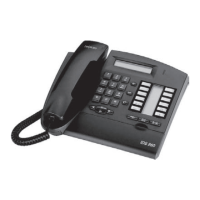






Do you have a question about the Alcatel OmniPCX Office and is the answer not in the manual?
| VoIP Support | Yes |
|---|---|
| SIP Support | Yes |
| ISDN Support | Yes |
| Analog Support | Yes |
| Integrated Voice Mail | Yes |
| Auto Attendant | Yes |
| Conferencing | Yes |
| VoIP Protocols | SIP, H.323 |
| Power Supply | 100-240 VAC, 50/60 Hz |
| Network Interfaces | 10/100 Mbps Ethernet |
| Humidity | 10% to 90% non-condensing |
Description of the navigation keys for browsing the display.
Explains the functions of the guide key for information and programming.
Disables the microphone during a call to prevent the correspondent from hearing you.
Key used to terminate a call or programming session.
Details the speakerphone and volume control keys.
Information on the keypad used for name dialing and programming.
Learn to make and answer calls using the hands-free function without lifting the receiver.
Instructions for placing calls to external numbers using the telephone.
Guide on how to place calls to internal extensions or colleagues.
How to find and call contacts using the company directory by name.
Accessing and making calls to contacts stored in your personal directory.
How to use the shared common directory for external numbers.
Procedures for answering incoming telephone calls.
Using the voice mailbox feature to filter incoming calls.
Redialing previously dialed numbers from the call history.
Saving a number to call back later without using the full directory.
Setting up a callback request when an internal number is busy.
How to answer internal calls directly in hands-free mode.
Transmitting DTMF tones during a call for automated systems.
Procedures for establishing calls using the ISDN network.
Methods to conceal your caller ID when making ISDN calls.
Requesting information to identify malicious or nuisance calls.
Activating the speakerphone during an active call with the handset lifted.
Disabling your microphone to prevent the other party from hearing you.
How to initiate a new call while already engaged in a conversation.
Procedures for handling an incoming call while on another active call.
Steps to forward an ongoing call to another number or extension.
Managing multiple active calls, switching between them as needed.
How to connect three parties for a conference call.
Instructions for temporarily suspending an active call.
Holding an external call to be retrieved later, possibly from another phone.
Information on how to handle calls that are waiting or 'camped-on'.
How to join an ongoing internal call if permitted.
Saving a number to the directory while a call is in progress.
How to receive special ringing signals for calls directed to another number.
How to answer calls indicated by a general bell when the operator is absent.
Setting up call filtering for designated manager/secretary groups.
How to answer calls ringing on other extensions within a group.
Temporarily taking calls intended for the operator.
Listening in on calls directed to other extensions.
How to make calls to or exit from a hunting group.
Paging an internal contact when they do not answer directly.
Remotely activating a correspondent's loudspeaker if they don't answer.
Composing and sending text messages to internal users.
Sending text messages to ISDN contacts.
Copying and sending voice messages.
Recording and sending messages to specific numbers or lists.
Sending audio announcements to multiple terminals in a group.
How to answer calls that have been paged.
Transferring an outside line to another terminal for external calls.
Choosing which types of calls (outside, internal, all) to divert.
Setting up immediate call forwarding to another number.
Forwarding all calls directly to your voice messaging system.
Activating or deactivating the personal assistant feature.
Configuring the personal assistant to use a single contact number.
Forwarding incoming calls to your pager.
Setting up call forwarding to receive calls at your current location.
Setting call diversions based on the caller's identity.
Forwarding all calls intended for a group to another internal number.
Deactivating all previously set call forwarding rules.
Removing a particular call diversion setting.
Automatically forwarding calls when your line is occupied.
Temporarily making your terminal unavailable for all incoming calls.
Accessing and reviewing voice messages upon returning.
Recording messages to be displayed on internal callers' screens.
Reading text-based messages received on the terminal.
Assigning the cost of outside calls to specific business account numbers.
Retrieving cost information for outside calls made on behalf of internal users.
Procedures for charging external calls made from home or while traveling to the company account.
Setting up your personal voice mailbox for the first time.
Recording a personal greeting message for your voice mailbox.
Changing your security code for accessing the voice mailbox or locking the phone.
Customizing the telephone's ringtone and adjusting the ringer volume.
Modifying the display's brightness level for better visibility.
Choosing the language for the telephone's interface and display.
Assigning phone numbers or functions to speed dial keys.
Adding, editing, or deleting contacts in your personal address book.
Setting up timed reminders for appointments or events.
Determining which terminal you are currently using.
Playing background music through the telephone's loudspeaker.
Securing the telephone to prevent unauthorized use or changes.